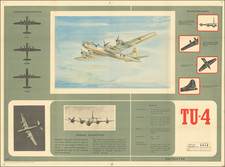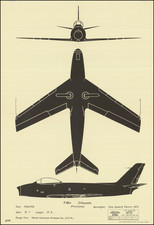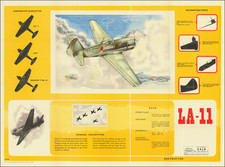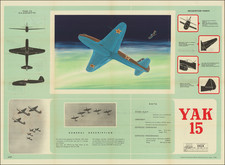Early Cold War British Military Information On the U.S. F-86
A very nice example from a series of posters produced by the British government to help identify aircraft at the outset of the Cold War. This poster, printed by Fosh & Cross Ltd. (the primary printer of posters and propaganda for the British Government) in London, is an early example of this practice and shows the newly commissioned U.S. jet fighter, the F-86A.
The poster showcases three silhouettes of the F-86, detailing its operational duty and the General Electric J47A engine. Interestingly, the poster, marked as Issue One of Sheet One, was published in August 1948, despite the F-86 not being officially in service until 1949. This suggests the poster was made with classified U.S. government information, likely as part of a strategic alliance for the new fighter plane's implementation.
The F-86 Sabre
Developed by North American Aviation as a counter to the popular Soviet fighters like the YAK-9 and the MiG, the F-86 Sabre is an iconic aircraft of the early Cold War. The F-86 was designed as a transonic jet fighter that could cross the Atlantic relatively quickly. The need to develop fighters capable of a quick response throughout Europe was paramount for U.S. strategic command. As such, the F-86 boasted incredible speeds of around 700 miles per hour and a tailplane that further enhanced the maneuverability of this aircraft.
The F-86 would enter service in 1949 and soon saw extensive use in the Korean War. During the conflict, the F-86's design would be put to the test as it faced off against Soviet MiG-15s. The two planes were more or less an even match mechanically, so many dogfights came down to training and teamwork. According to official records, the F-86 had a favorable performance against its Soviet counterparts, largely due to the training of its pilots. Throughout its service life, the F-86 would be upgraded and adapted for specific situations and conflicts. The United States decommissioned the F-86 by the early 1960s in favor of more advanced fighters, but many allied countries adopted the F-86 as the U.S. gave unwanted military goods to friendly countries.









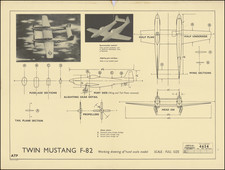
![(Cold War-Soviet Aircraft Identification) Russian Built B-29 [ Tupolex Tu-4]](https://storage.googleapis.com/raremaps/img/small/96736.jpg)
